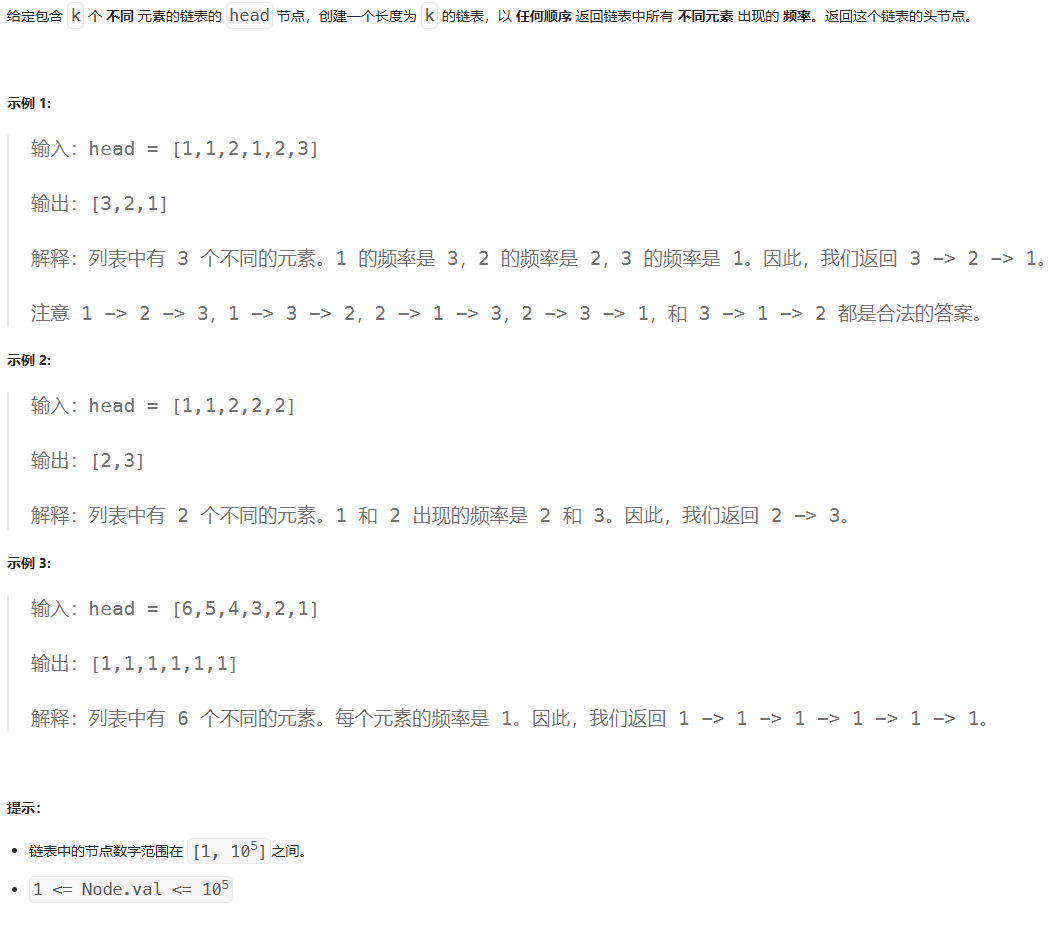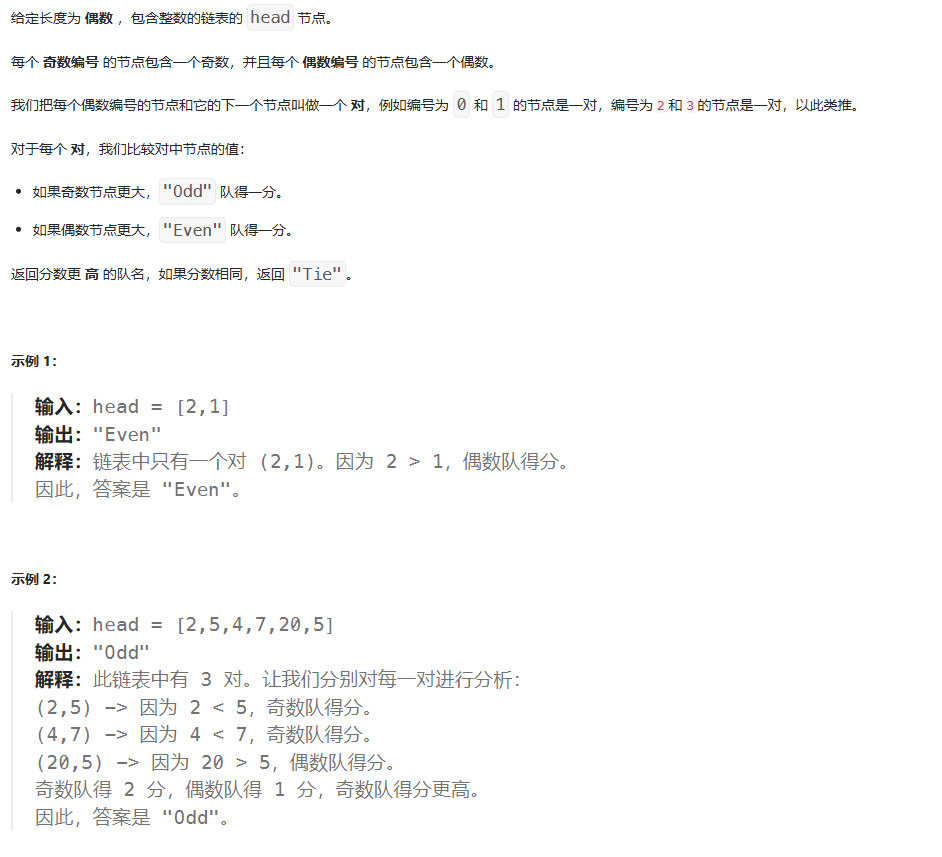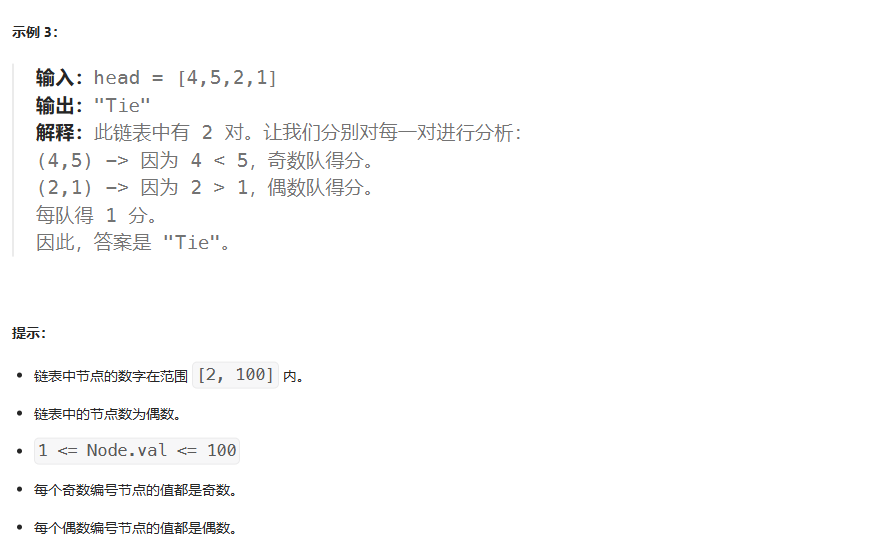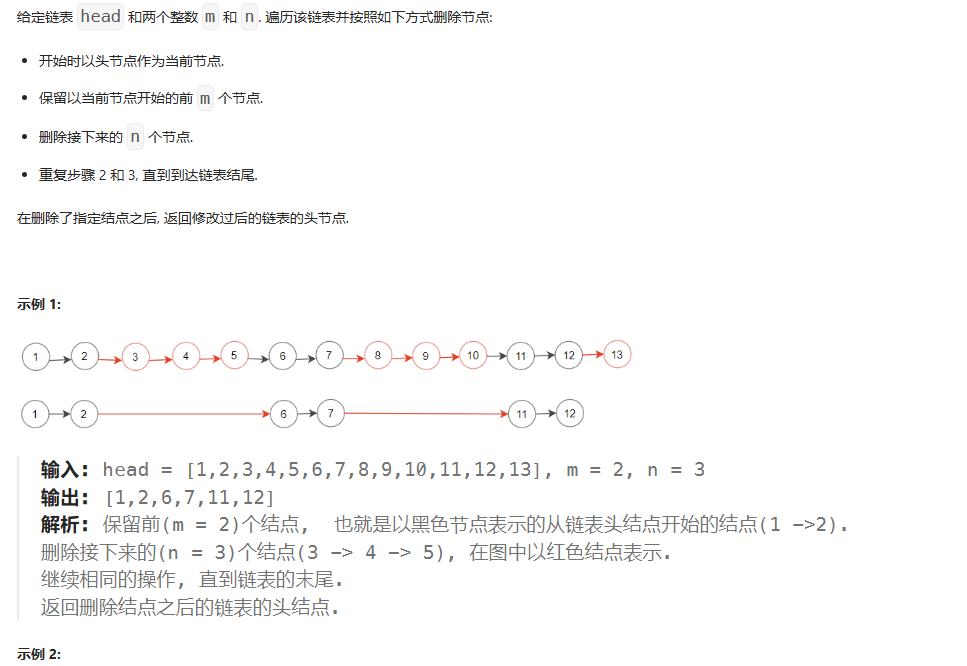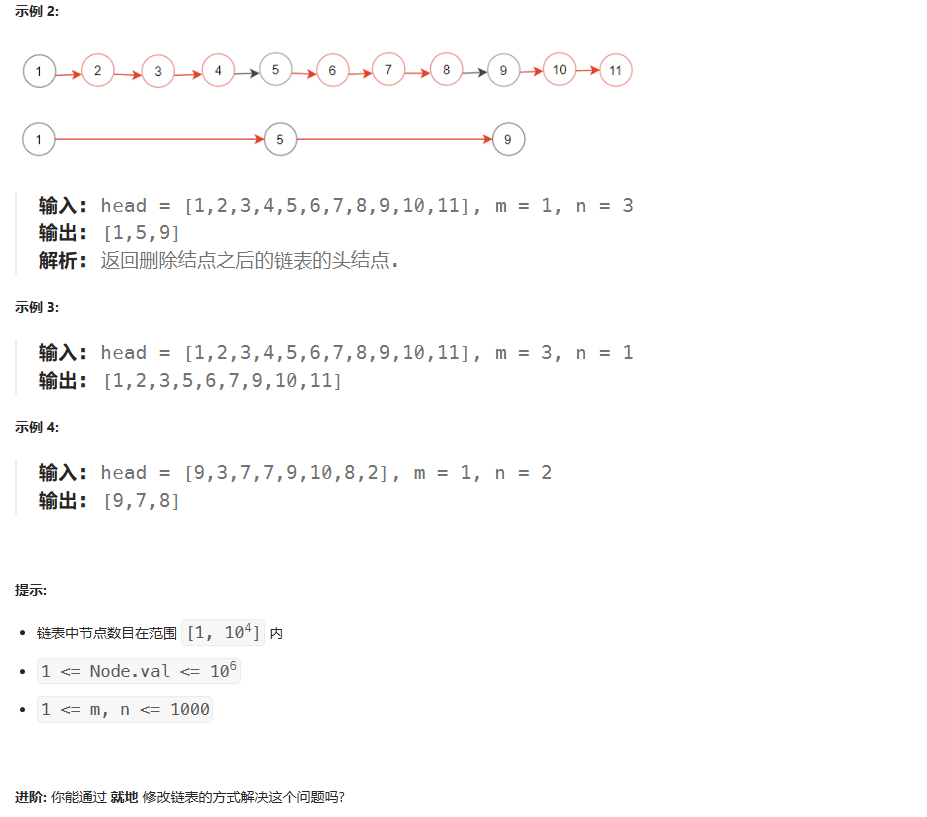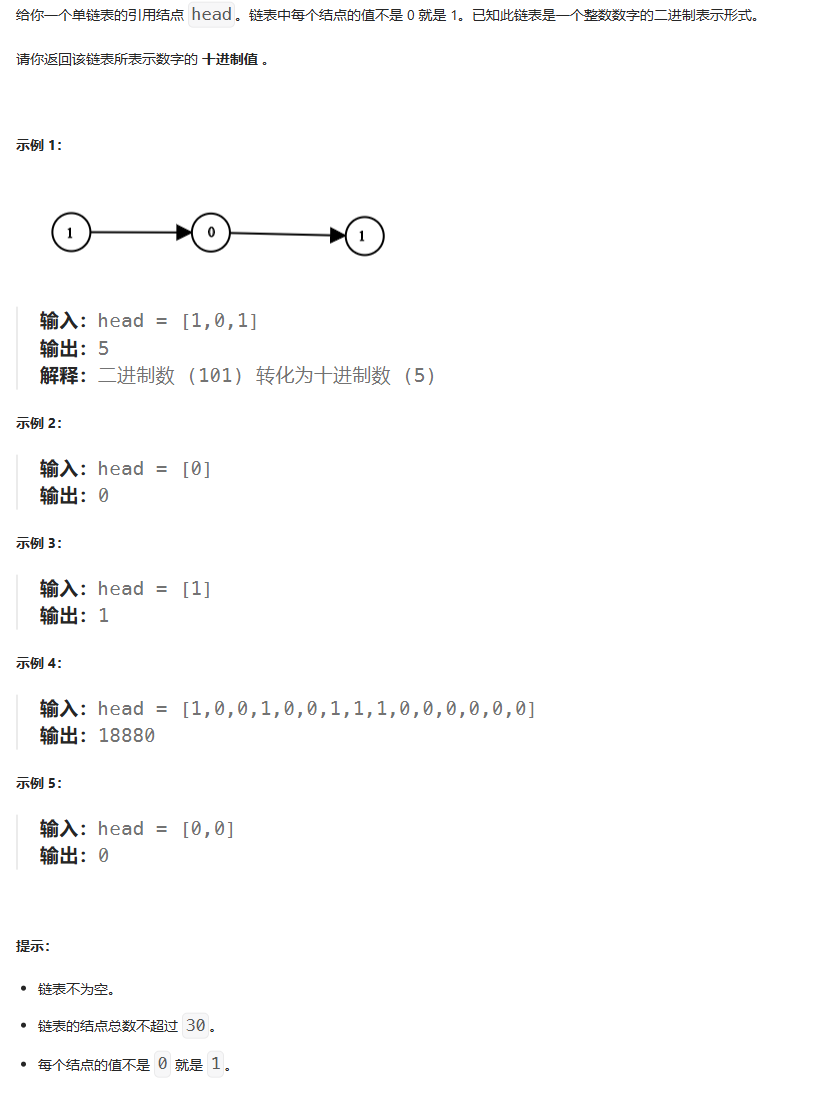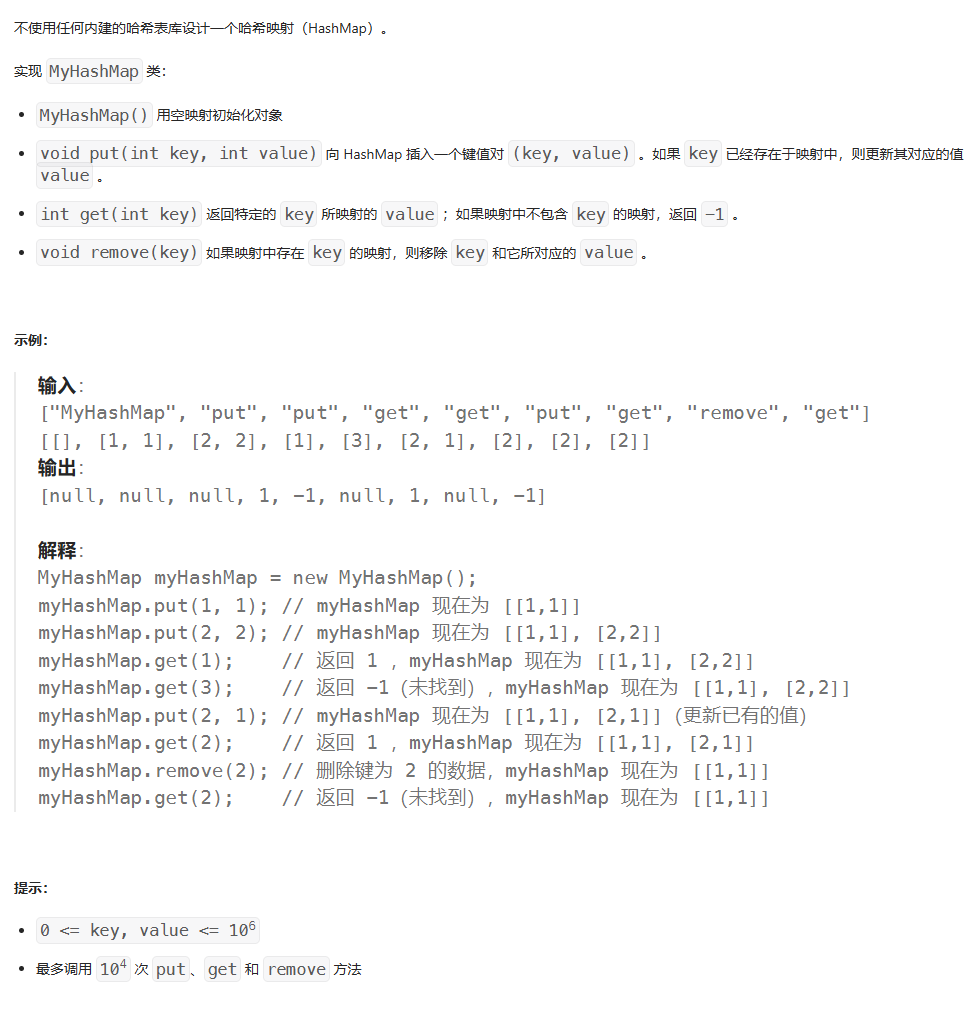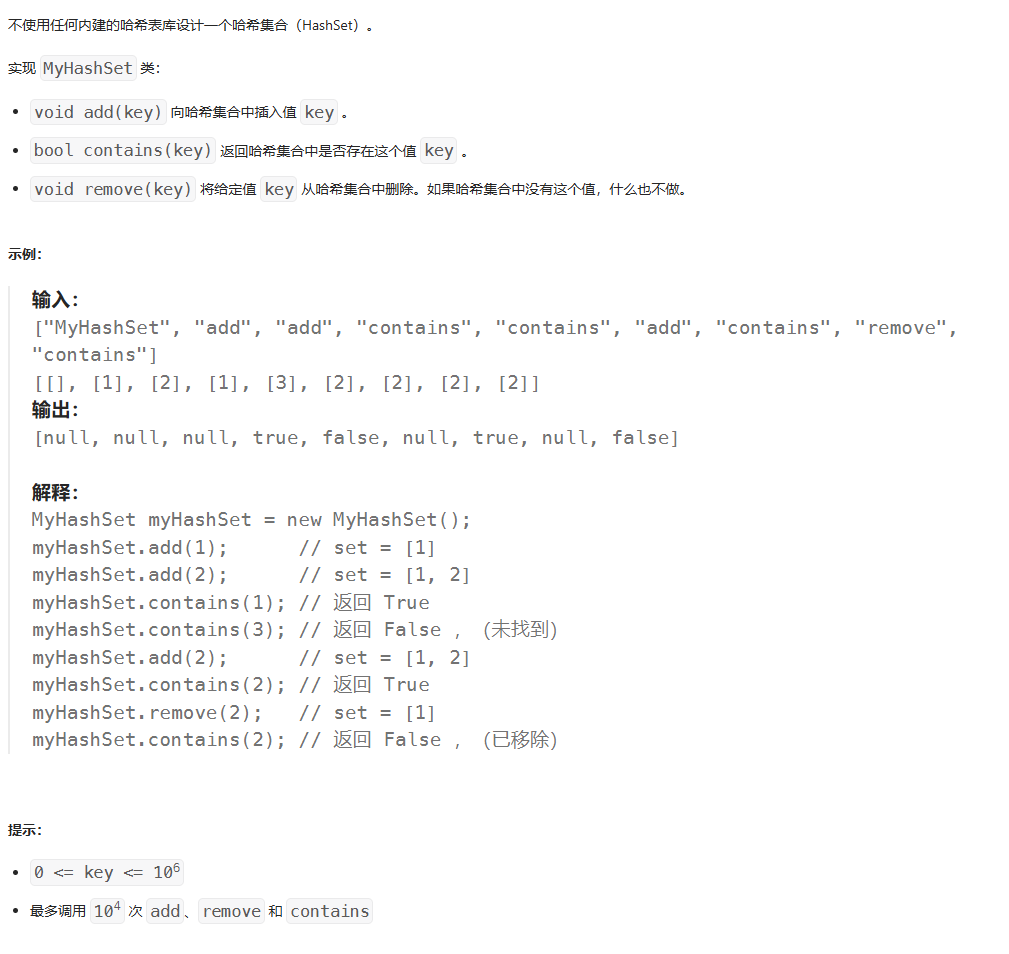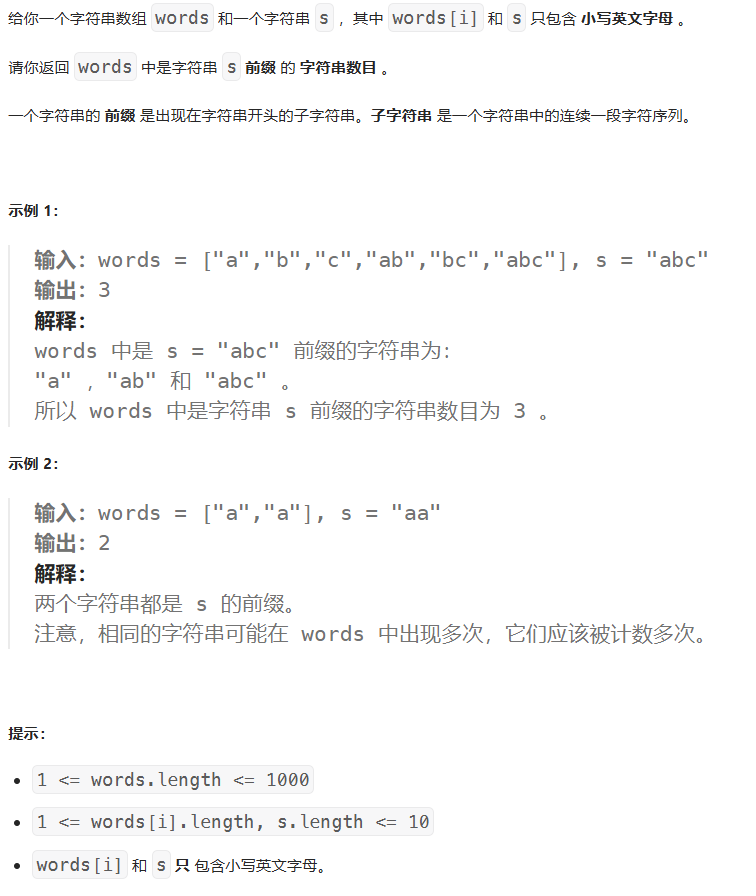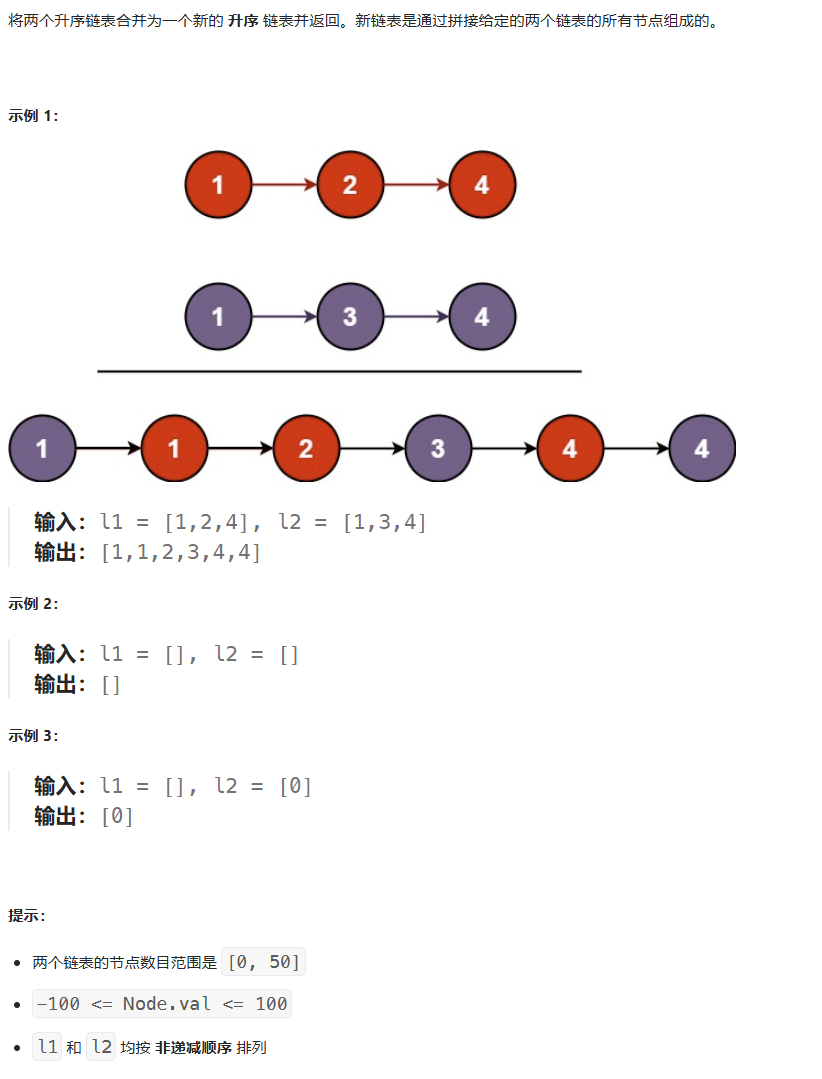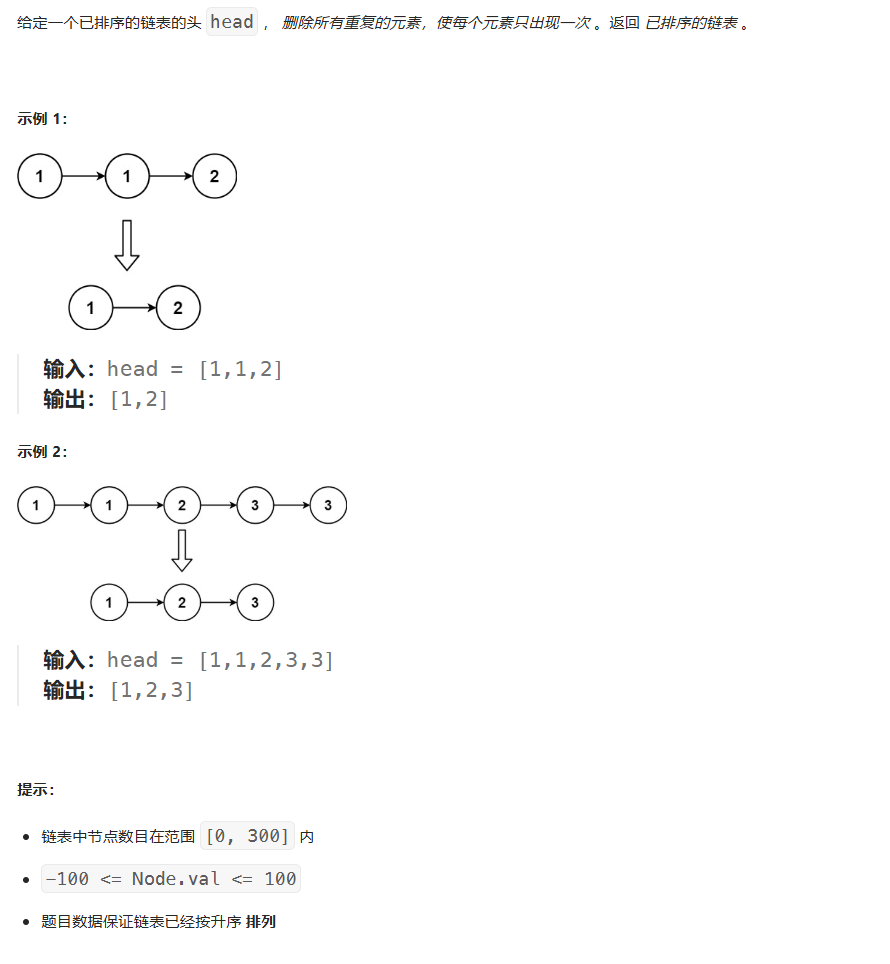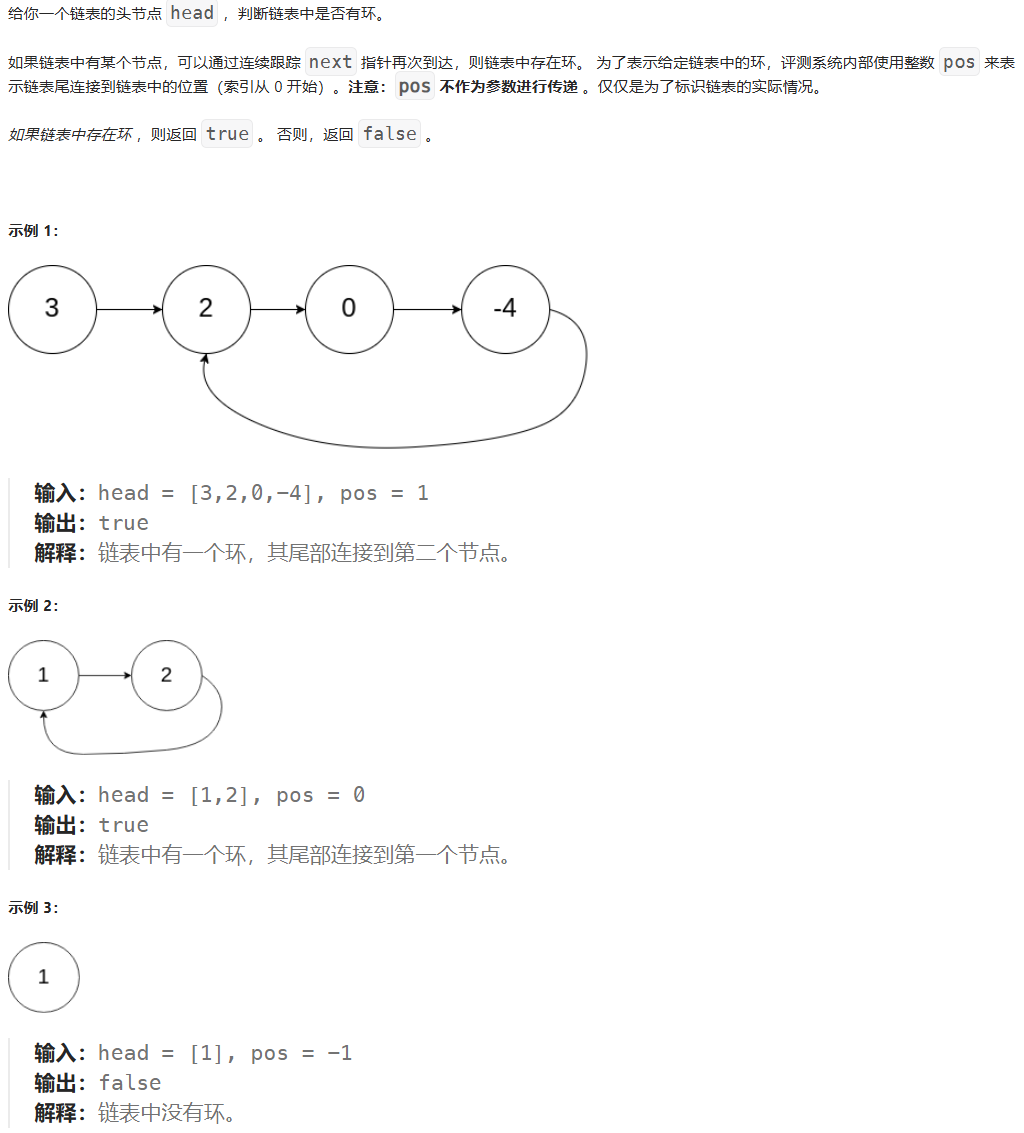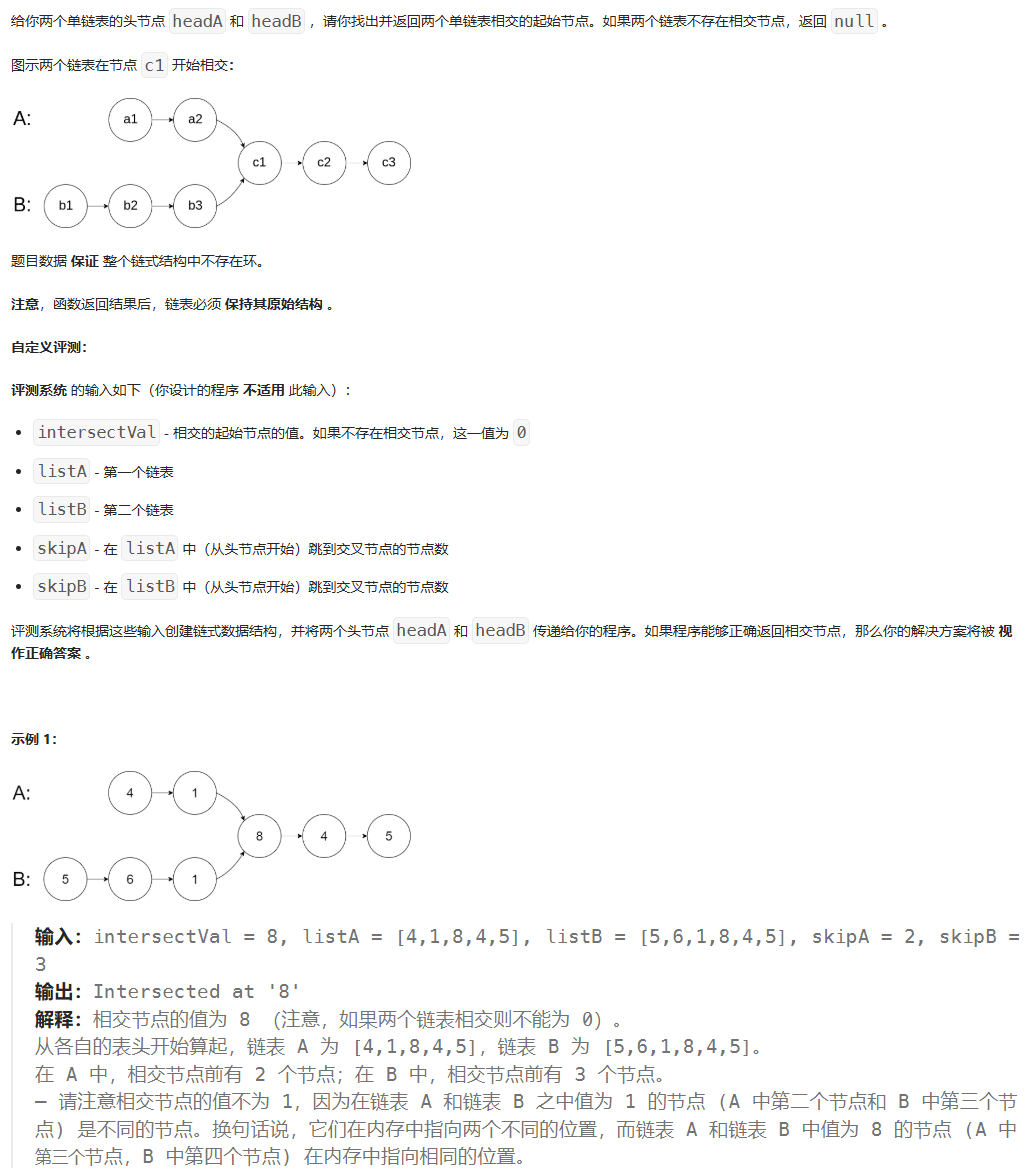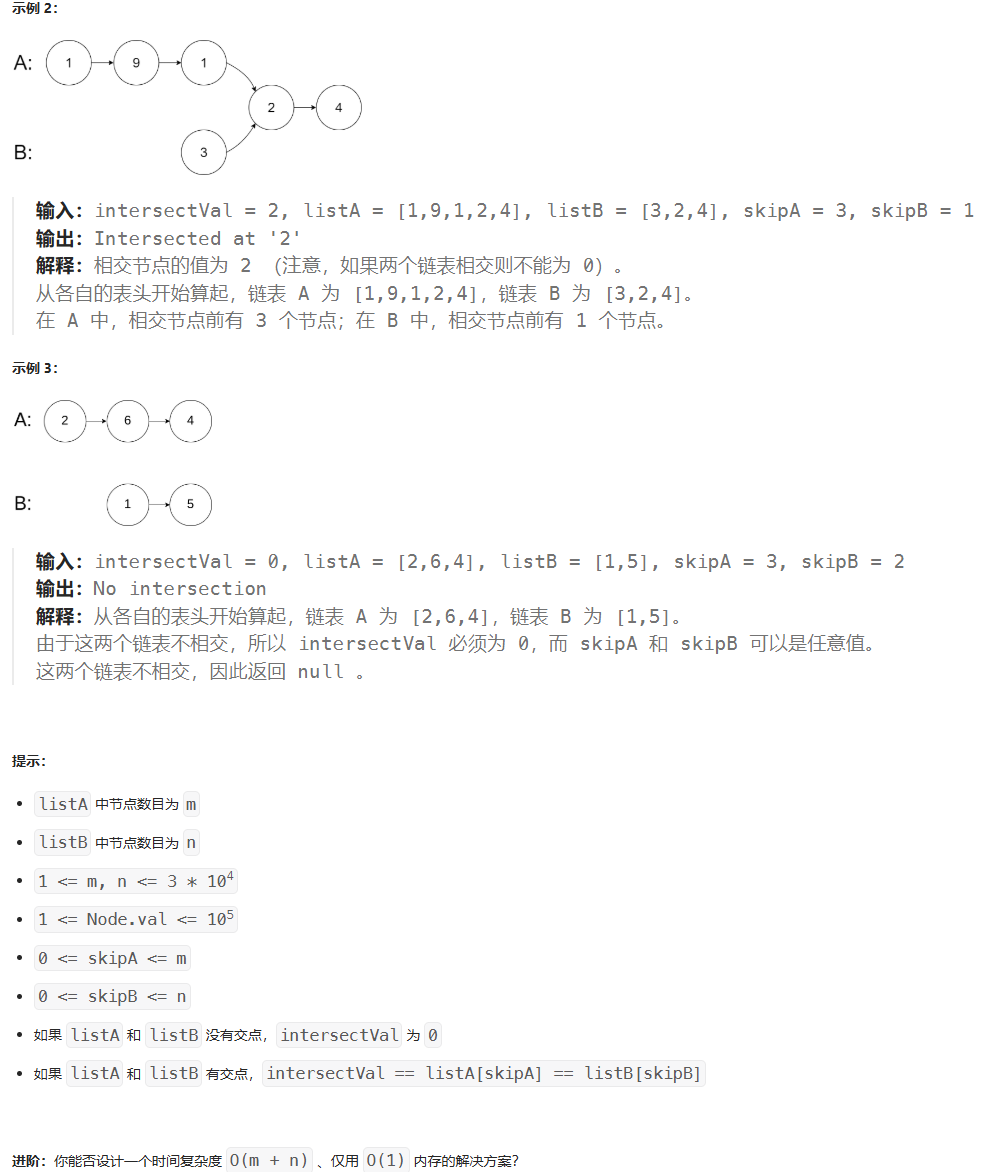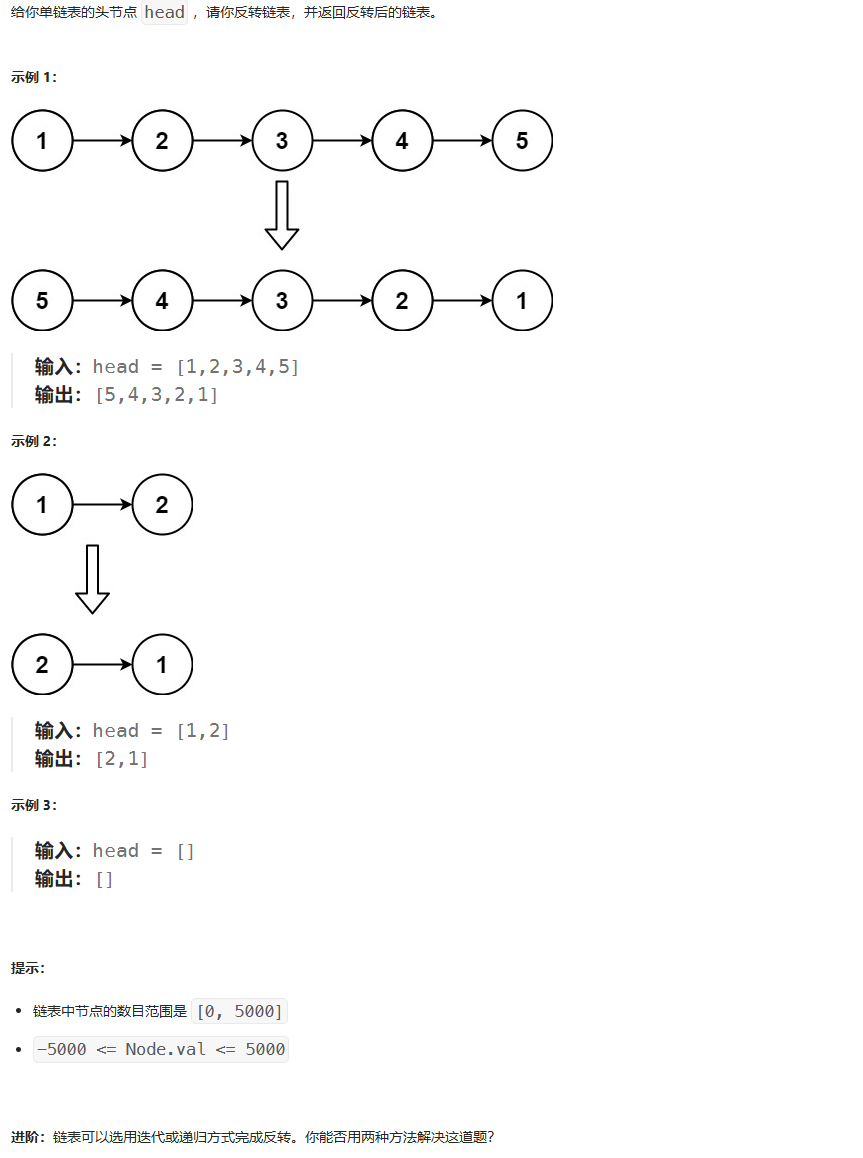LCR 023 相交链表
Question
- 和
160题一样
Ans1
|
1 2 3 4 5 6 7 8 9 10 11 12 13 14 15 16 17 18 19 20 21 22 23 24 25 26 27 28 29 |
/** * Definition for singly-linked list. * struct ListNode { * int val; * ListNode *next; * ListNode(int x) : val(x), next(NULL) {} * }; */ class Solution { public: ListNode *getIntersectionNode(ListNode *headA, ListNode *headB) { unordered_set<ListNode*> nodes; ListNode* tmpa = headA; while(tmpa) { nodes.emplace(tmpa); tmpa = tmpa->next; } ListNode* tmpb = headB; while(tmpb) { if (nodes.count(tmpb)) { return tmpb; } tmpb = tmpb->next; } return nullptr; } }; |
Ans2
|
1 2 3 4 5 6 7 8 9 10 11 12 13 14 15 16 17 18 19 20 21 |
/** * Definition for singly-linked list. * struct ListNode { * int val; * ListNode *next; * ListNode(int x) : val(x), next(NULL) {} * }; */ class Solution { public: ListNode *getIntersectionNode(ListNode *headA, ListNode *headB) { ListNode* a = headA; ListNode* b = headB; while(a != b) { a = (a == nullptr) ? headB : a->next; b = (b == nullptr) ? headA : b->next; } return a; } }; |
3263 将双链表转为数组1
Question
Ans
- 效率一般
|
1 2 3 4 5 6 7 8 9 10 11 12 13 14 15 16 17 18 19 20 21 22 23 24 |
/** * Definition for doubly-linked list. * class Node { * int val; * Node* prev; * Node* next; * Node() : val(0), next(nullptr), prev(nullptr) {} * Node(int x) : val(x), next(nullptr), prev(nullptr) {} * Node(int x, Node *prev, Node *next) : val(x), next(next), prev(prev) {} * }; */ class Solution { public: vector<int> toArray(Node *head){ std::vector<int> res; while(head) { res.emplace_back(head->val); head = head->next; } return res; } }; |
3063 链表频率
Question
Ans1
- 我的版本,使用
map来完成,效率一般
|
1 2 3 4 5 6 7 8 9 10 11 12 13 14 15 16 17 18 19 20 21 22 23 24 25 26 27 28 |
/** * Definition for singly-linked list. * struct ListNode { * int val; * ListNode *next; * ListNode() : val(0), next(nullptr) {} * ListNode(int x) : val(x), next(nullptr) {} * ListNode(int x, ListNode *next) : val(x), next(next) {} * }; */ class Solution { public: ListNode* frequenciesOfElements(ListNode* head) { std::map<int,int> data; while(head) { data[head->val]++; head = head->next; } ListNode node(0); ListNode* cur = &node; for (auto item : data) { cur->next = new ListNode(item.second); cur = cur->next; } return node.next; } }; |
Ans2
- 优化
ans1,明显缩短了执行时间
|
1 2 3 4 5 6 7 8 9 10 11 12 13 14 15 16 17 18 19 20 21 22 23 24 25 26 27 28 29 30 31 32 33 34 35 |
/** * Definition for singly-linked list. * struct ListNode { * int val; * ListNode *next; * ListNode() : val(0), next(nullptr) {} * ListNode(int x) : val(x), next(nullptr) {} * ListNode(int x, ListNode *next) : val(x), next(next) {} * }; */ class Solution { public: ListNode* frequenciesOfElements(ListNode* head) { unordered_map<int, int> data; vector<int> keys; while(head) { if (data.find(head->val) == data.end()) { keys.push_back(head->val); } data[head->val]++; head = head->next; } std::sort(keys.begin(), keys.end()); ListNode dmp(0); ListNode* cur = &dmp; for (const auto& item : keys) { cur->next = new ListNode(data[item]); cur = cur->next; } return dmp.next; } }; |
3062 链表游戏的获胜者
Question
Ans
|
1 2 3 4 5 6 7 8 9 10 11 12 13 14 15 16 17 18 19 20 21 22 23 24 25 26 27 |
/** * Definition for singly-linked list. * struct ListNode { * int val; * ListNode *next; * ListNode() : val(0), next(nullptr) {} * ListNode(int x) : val(x), next(nullptr) {} * ListNode(int x, ListNode *next) : val(x), next(next) {} * }; */ class Solution { public: string gameResult(ListNode* head) { int odd = 0; int even = 0; while(head) { if (head->val < head->next->val) { odd++; } else { even++; } head = head->next->next; } return (odd > even) ? "Odd" : (odd == even) ? "Tie" : "Even"; } }; |
1474 删除链表M个节点之后的N个节点
Question
Ans1
- 我的方法,循环处理,达到效果
|
1 2 3 4 5 6 7 8 9 10 11 12 13 14 15 16 17 18 19 20 21 22 23 24 25 26 27 28 29 30 31 32 33 34 35 36 37 38 39 40 41 42 43 44 |
/** * Definition for singly-linked list. * struct ListNode { * int val; * ListNode *next; * ListNode() : val(0), next(nullptr) {} * ListNode(int x) : val(x), next(nullptr) {} * ListNode(int x, ListNode *next) : val(x), next(next) {} * }; */ class Solution { public: ListNode* deleteNodes(ListNode* head, int m, int n) { int count = 0; ListNode* tmp = head; while(tmp) { if (count == m-1) { ListNode* goal = tmp->next; if (!goal) { break; } int tmpn = n; while(goal && (tmpn != 0)) { tmpn--; goal = goal->next; } if (!goal) { tmp->next = goal; break; } tmp->next = goal; tmp = tmp->next; count = 0; continue; } count++; tmp = tmp->next; } return head; } }; |
Ans2
ans1的代码优化版本,逻辑是一样的
|
1 2 3 4 5 6 7 8 9 10 11 12 13 14 15 16 17 18 19 20 21 22 23 24 25 26 27 28 29 30 31 32 33 34 |
/** * Definition for singly-linked list. * struct ListNode { * int val; * ListNode *next; * ListNode() : val(0), next(nullptr) {} * ListNode(int x) : val(x), next(nullptr) {} * ListNode(int x, ListNode *next) : val(x), next(next) {} * }; */ class Solution { public: ListNode* deleteNodes(ListNode* head, int m, int n) { ListNode* cur = head; ListNode* last = head; while(cur) { int mm = m, nn = n; while (cur && (mm != 0)) { last = cur; cur = cur->next; mm--; } while(cur && (nn != 0)) { cur = cur->next; nn--; } last->next = cur; } return head; } }; |
1290 二进制链表转整数
Question
Ans1
- 先反转链表,然后从低位开始不断计算
|
1 2 3 4 5 6 7 8 9 10 11 12 13 14 15 16 17 18 19 20 21 22 23 24 25 26 27 28 29 30 31 32 33 34 35 36 37 |
/** * Definition for singly-linked list. * struct ListNode { * int val; * ListNode *next; * ListNode() : val(0), next(nullptr) {} * ListNode(int x) : val(x), next(nullptr) {} * ListNode(int x, ListNode *next) : val(x), next(next) {} * }; */ #include <cmath> class Solution { public: int getDecimalValue(ListNode* head) { ListNode* prev = nullptr; ListNode* cur = head; ListNode* next = nullptr; while(cur) { next = cur->next; cur->next = prev; prev = cur; cur = next; } int count = 0; int sum = 0; while(prev) { sum += prev->val * pow(2, count); count++; prev = prev->next; } return sum; } }; |
Ans2
- 构建
res的二进制位,每次循环先左移一位,确保末尾是0,让这个0去和下一位去或运算
|
1 2 3 4 5 6 7 8 9 10 11 12 13 14 15 16 17 18 19 20 21 22 |
/** * Definition for singly-linked list. * struct ListNode { * int val; * ListNode *next; * ListNode() : val(0), next(nullptr) {} * ListNode(int x) : val(x), next(nullptr) {} * ListNode(int x, ListNode *next) : val(x), next(next) {} * }; */ class Solution { public: int getDecimalValue(ListNode* head) { int res = 0; while(head) { res <<= 1; res |= head->val; head = head->next; } return res; } }; |
Ans3
- 原理和
ans2一样
|
1 2 3 4 5 6 7 8 9 10 11 12 13 14 15 16 17 18 19 20 21 |
/** * Definition for singly-linked list. * struct ListNode { * int val; * ListNode *next; * ListNode() : val(0), next(nullptr) {} * ListNode(int x) : val(x), next(nullptr) {} * ListNode(int x, ListNode *next) : val(x), next(next) {} * }; */ class Solution { public: int getDecimalValue(ListNode* head) { int res = 0; while(head) { res = res*2 + head->val; head = head->next; } return res; } }; |
876 链表的中间节点
Question
Ans1
- 我的方法,快慢指针
|
1 2 3 4 5 6 7 8 9 10 11 12 13 14 15 16 17 18 19 20 21 22 23 24 25 26 27 28 |
/** * Definition for singly-linked list. * struct ListNode { * int val; * ListNode *next; * ListNode() : val(0), next(nullptr) {} * ListNode(int x) : val(x), next(nullptr) {} * ListNode(int x, ListNode *next) : val(x), next(next) {} * }; */ class Solution { public: ListNode* middleNode(ListNode* head) { ListNode* slow = head; ListNode* fast = head; while(slow && fast && fast->next) { slow = slow->next; if (fast->next) { fast = fast->next->next; } else { break; } } return slow; } }; |
Ans2
- 用
vector去保存head,只要head有指向一个节点,就不断把下一个节点添加到vector里面
|
1 2 3 4 5 6 7 8 9 10 11 12 13 14 15 16 17 18 19 20 |
/** * Definition for singly-linked list. * struct ListNode { * int val; * ListNode *next; * ListNode() : val(0), next(nullptr) {} * ListNode(int x) : val(x), next(nullptr) {} * ListNode(int x, ListNode *next) : val(x), next(next) {} * }; */ class Solution { public: ListNode* middleNode(ListNode* head) { std::vector<ListNode*> vec {head}; while (vec.back()->next) { vec.push_back(vec.back()->next); } return vec.at(vec.size()/2); } }; |
Ans3
- 单指针遍历出链表长度,计算出中间节点
- 似乎性能不如快慢指针
|
1 2 3 4 5 6 7 8 9 10 11 12 13 14 15 16 17 18 19 20 21 22 23 24 25 26 27 28 29 30 31 32 |
/** * Definition for singly-linked list. * struct ListNode { * int val; * ListNode *next; * ListNode() : val(0), next(nullptr) {} * ListNode(int x) : val(x), next(nullptr) {} * ListNode(int x, ListNode *next) : val(x), next(next) {} * }; */ class Solution { public: ListNode* middleNode(ListNode* head) { int count = 0; ListNode* tmp = head; while(tmp) { count++; tmp = tmp->next; } tmp = head; int sz = 0; while(tmp) { sz++; if (sz == (count/2+1)) { return tmp; } tmp = tmp->next; } return tmp; } }; |
706 设计哈希映射
Question
Ans1
- 性能不好
|
1 2 3 4 5 6 7 8 9 10 11 12 13 14 15 16 17 18 19 20 21 22 23 24 25 26 27 28 29 30 31 32 33 34 35 36 37 38 39 40 41 42 43 44 45 46 |
class MyHashMap { std::vector<std::pair<int, int>> data; public: MyHashMap() { } void put(int key, int value) { for (auto& item : data) { if (item.first == key) { item.second = value; return; } } data.emplace_back(key, value); } int get(int key) { for (auto & item : data) { if (item.first == key) { return item.second; } } return -1; } void remove(int key) { using iter = std::vector<std::pair<int, int>>::iterator; for (iter ite = data.begin(); ite != data.end(); ) { if ((*ite).first == key) { data.erase(ite); } else { ite++; } } } }; /** * Your MyHashMap object will be instantiated and called as such: * MyHashMap* obj = new MyHashMap(); * obj->put(key,value); * int param_2 = obj->get(key); * obj->remove(key); */ |
Ans2
- 好了一些
|
1 2 3 4 5 6 7 8 9 10 11 12 13 14 15 16 17 18 19 20 21 22 23 24 25 26 27 28 29 30 31 32 33 34 35 36 37 38 39 40 41 42 43 44 45 46 47 48 49 50 51 |
class MyHashMap { private: vector<list<pair<int,int>>> data; static const int base = 789; int hash(int key) { return key % 789; } public: MyHashMap() : data(base) { } void put(int key, int value) { int h = hash(key); for (auto ite = data[h].begin(); ite != data[h].end(); ite++) { if (ite->first == key) { ite->second = value; return; } } data[h].push_back(make_pair(key, value)); } int get(int key) { int h = hash(key); for (auto ite = data[h].begin(); ite != data[h].end(); ite++) { if (ite->first == key) { return ite->second; } } return -1; } void remove(int key) { int h = hash(key); for (auto ite = data[h].begin(); ite != data[h].end(); ite++) { if (ite->first == key) { data[h].erase(ite); return; } } } }; /** * Your MyHashMap object will be instantiated and called as such: * MyHashMap* obj = new MyHashMap(); * obj->put(key,value); * int param_2 = obj->get(key); * obj->remove(key); */ |
705 设计哈希集合
Question
Ans1
- 通过了,但是性能很差
|
1 2 3 4 5 6 7 8 9 10 11 12 13 14 15 16 17 18 19 20 21 22 23 24 25 26 27 28 29 30 31 32 33 34 35 36 37 38 39 40 41 42 43 44 45 |
class MyHashSet { private: std::list<int> map; std::list<int>::iterator find_key(int key) { auto ite = map.begin(); while(ite != map.end()) { if (*ite == key) { return ite; } ite++; } return map.end(); } public: MyHashSet() { } void add(int key) { if (!contains(key)) { map.push_back(key); } } void remove(int key) { auto ite = find_key(key); if (ite != map.end()) { map.remove(key); } } bool contains(int key) { return find_key(key) != map.end(); } }; /** * Your MyHashSet object will be instantiated and called as such: * MyHashSet* obj = new MyHashSet(); * obj->add(key); * obj->remove(key); * bool param_3 = obj->contains(key); */ |
Ans2
|
1 2 3 4 5 6 7 8 9 10 11 12 13 14 15 16 17 18 19 20 21 22 23 24 25 26 27 28 29 30 31 32 33 34 35 36 37 38 39 40 41 42 43 44 45 46 47 48 49 50 51 52 53 54 55 56 57 58 59 60 61 62 63 64 |
class MyHashSet { vector<list<int>> bukets; static const int base = 789; int hash(int key) { return key % 789; } std::list<int>::iterator find_key(std::list<int>& lst, int key) { for (std::list<int>::iterator ite = lst.begin(); ite != lst.end(); ite++) { if (*ite == key) { return ite; } } return lst.end(); } std::list<int>& get_list(int key) { auto hs = hash(key); return bukets[hs]; } public: MyHashSet() : bukets(base) { } void add(int key) { int h = hash(key); for (auto ite = bukets[h].begin(); ite != bukets[h].end(); ite++) { if (*ite == key) { return; } } bukets[h].push_back(key); } void remove(int key) { int h = hash(key); for (auto ite = bukets[h].begin(); ite != bukets[h].end(); ite++) { if (*ite == key) { bukets[h].erase(ite); return; } } } bool contains(int key) { int h = hash(key); for (auto ite = bukets[h].begin(); ite != bukets[h].end(); ite++) { if (*ite == key) { return true; } } return false; } }; /** * Your MyHashSet object will be instantiated and called as such: * MyHashSet* obj = new MyHashSet(); * obj->add(key); * obj->remove(key); * bool param_3 = obj->contains(key); */ |
2255 统计是给定字符串前缀的字符串数目
Question
Ans1
|
1 2 3 4 5 6 7 8 9 10 11 12 13 14 15 16 |
class Solution { public: int countPrefixes(vector<string>& words, string s) { int count = 0; for (auto & item : words) { if(item.size() > s.size()) { continue; } if (s.compare(0, item.size(), item) == 0) { count++; } } return count; } }; |
21 合并两个有序链表
Question
Ans
|
1 2 3 4 5 6 7 8 9 10 11 12 13 14 15 16 17 18 19 20 21 22 23 24 25 26 27 28 29 30 31 32 |
/** * Definition for singly-linked list. * struct ListNode { * int val; * ListNode *next; * ListNode() : val(0), next(nullptr) {} * ListNode(int x) : val(x), next(nullptr) {} * ListNode(int x, ListNode *next) : val(x), next(next) {} * }; */ class Solution { public: ListNode* mergeTwoLists(ListNode* list1, ListNode* list2) { ListNode tmp(0); ListNode* tail = &tmp; while (list1 && list2) { if (list1->val < list2->val) { tail->next = list1; list1 = list1->next; } else { tail->next = list2; list2 = list2->next; } tail = tail->next; } tail->next = list1 ? list1 : list2; return tmp.next; } }; |
83 删除排序链表中的重复元素
Question
Ans1
|
1 2 3 4 5 6 7 8 9 10 11 12 13 14 15 16 17 18 19 20 21 22 23 24 25 26 27 28 29 30 31 32 33 34 35 36 37 38 39 40 41 42 43 |
/** * Definition for singly-linked list. * struct ListNode { * int val; * ListNode *next; * ListNode() : val(0), next(nullptr) {} * ListNode(int x) : val(x), next(nullptr) {} * ListNode(int x, ListNode *next) : val(x), next(next) {} * }; */ class Solution { public: ListNode* deleteDuplicates(ListNode* head) { if (!head) { return nullptr; } if (!head->next) { return head; } ListNode* tmp = head; head = head->next; tmp->next = nullptr; ListNode* tail = tmp; int tmp_val = tmp->val; while(head) { if (head->val != tmp_val) { ListNode* tmp1 = head->next; head->next = tail->next; tail->next = head; tmp_val = head->val; tail = tail->next; head = tmp1; } else { head = head->next; } } return tmp; } }; |
Ans2
|
1 2 3 4 5 6 7 8 9 10 11 12 13 14 15 16 17 18 19 20 21 22 23 24 25 26 27 28 |
/** * Definition for singly-linked list. * struct ListNode { * int val; * ListNode *next; * ListNode() : val(0), next(nullptr) {} * ListNode(int x) : val(x), next(nullptr) {} * ListNode(int x, ListNode *next) : val(x), next(next) {} * }; */ class Solution { public: ListNode* deleteDuplicates(ListNode* head) { if (!head) { return head; } ListNode* cur = head; while(cur->next) { if (cur->next->val == cur->val) { cur->next = cur->next->next; } else { cur = cur->next; } } return head; } }; |
141 环形链表
Question
Ans1
- 快慢指针
|
1 2 3 4 5 6 7 8 9 10 11 12 13 14 15 16 17 18 19 20 21 22 23 24 25 26 27 |
/** * Definition for singly-linked list. * struct ListNode { * int val; * ListNode *next; * ListNode(int x) : val(x), next(NULL) {} * }; */ class Solution { public: bool hasCycle(ListNode *head) { if (!head || !head->next) { return false; } ListNode* slow = head; ListNode* fast = head; while(fast && fast->next) { slow = slow->next; fast = fast->next->next; if (slow == fast) { return true; } } return false; } }; |
Ans2
- 用了
std::unordered_set统计结点出现的次数
|
1 2 3 4 5 6 7 8 9 10 11 12 13 14 15 16 17 18 19 20 21 22 23 24 |
/** * Definition for singly-linked list. * struct ListNode { * int val; * ListNode *next; * ListNode(int x) : val(x), next(NULL) {} * }; */ class Solution { public: bool hasCycle(ListNode *head) { std::unordered_set<ListNode*> nodes; while(head) { if(nodes.count(head)) { return true; } nodes.emplace(head); head = head->next; } return false; } }; |
160 相交链表
Question
Ans1
- 效率较差
|
1 2 3 4 5 6 7 8 9 10 11 12 13 14 15 16 17 18 19 20 21 22 23 24 25 26 27 28 29 |
/** * Definition for singly-linked list. * struct ListNode { * int val; * ListNode *next; * ListNode(int x) : val(x), next(NULL) {} * }; */ class Solution { public: ListNode *getIntersectionNode(ListNode *headA, ListNode *headB) { ListNode* tmpa = headA; ListNode* tmpb = headB; while(tmpa) { while(tmpb) { if (tmpa == tmpb) { return tmpa; } tmpb = tmpb->next; } tmpb = headB; tmpa = tmpa->next; } return nullptr; } }; |
Ans2
- 使用
std::unordered_set将每个结点存一下 - 优化效果明显
|
1 2 3 4 5 6 7 8 9 10 11 12 13 14 15 16 17 18 19 20 21 22 23 24 25 26 27 28 29 |
/** * Definition for singly-linked list. * struct ListNode { * int val; * ListNode *next; * ListNode(int x) : val(x), next(NULL) {} * }; */ class Solution { public: ListNode *getIntersectionNode(ListNode *headA, ListNode *headB) { std::unordered_set<ListNode*> nodes; ListNode* tmpa = headA; while(tmpa) { nodes.emplace(tmpa); tmpa = tmpa->next; } ListNode* tmpb = headB; while(tmpb) { if (nodes.count(tmpb)) { return tmpb; } tmpb = tmpb->next; } return nullptr; } }; |
Ans3
- 最优的方法
|
1 2 3 4 5 6 7 8 9 10 11 12 13 14 15 16 17 18 19 20 21 |
/** * Definition for singly-linked list. * struct ListNode { * int val; * ListNode *next; * ListNode(int x) : val(x), next(NULL) {} * }; */ class Solution { public: ListNode *getIntersectionNode(ListNode *headA, ListNode *headB) { ListNode* tmpa = headA; ListNode* tmpb = headB; while(tmpa != tmpb) { tmpa = tmpa ? tmpa->next : headB; tmpb = tmpb ? tmpb->next : headA; } return tmpa; } }; |
- 思路如下:
- 设「第一个公共节点」为
node,「链表headA」的节点数量为a,「链表headB」的节点数量为b,「两链表的公共尾部」的节点数量为c,则有:- 头节点
headA到node前,共有a−c个节点 - 头节点
headB到node前,共有b−c个节点
- 头节点
- 考虑构建两个节点指针
A,B分别指向两链表头节点headA,headB,做如下操作:- 指针
A先遍历完链表headA,再开始遍历链表headB,当走到node时,共走步数为: a+(b-c)- 指针
B先遍历完链表headB,再开始遍历链表headA,当走到node时,共走步数为: b+(a-c)
- 指针
- 按上面的思路,两个指针遍历到公共节点时,
A和B重合,且走的步数相同- 公式上表现为:
a+(b-c)=b+(a-c) - 则有两种情况:
- 情况一:假如两个链表有公共尾部,也就是
c大于0的情况,指针A和B会同时指向公共节点node - 情况二:假如两个链表无公共尾部,也即是
c等于0的情况,指针A和B会同时指向nullptr
- 公式上表现为:
203 移除链表元素
Question
Ans1
|
1 2 3 4 5 6 7 8 9 10 11 12 13 14 15 16 17 18 19 20 21 22 23 24 25 26 27 28 29 30 31 32 33 34 35 36 37 38 39 |
/** * Definition for singly-linked list. * struct ListNode { * int val; * ListNode *next; * ListNode() : val(0), next(nullptr) {} * ListNode(int x) : val(x), next(nullptr) {} * ListNode(int x, ListNode *next) : val(x), next(next) {} * }; */ class Solution { public: ListNode* removeElements(ListNode* head, int val) { if (!head) { return head; } while(head) { if (head->val != val) { break; } head = head->next; } if (!head) { return head; } ListNode* cur = head; while(head->next) { if (head->next->val == val) { head->next = head->next->next; } else { head = head->next; } } return cur; } }; |
Ans2
- 递归的方式
|
1 2 3 4 5 6 7 8 9 10 11 12 13 14 15 16 17 18 19 20 21 22 23 24 25 26 |
/** * Definition for singly-linked list. * struct ListNode { * int val; * ListNode *next; * ListNode() : val(0), next(nullptr) {} * ListNode(int x) : val(x), next(nullptr) {} * ListNode(int x, ListNode *next) : val(x), next(next) {} * }; */ class Solution { public: ListNode* removeElements(ListNode* head, int val) { if (!head) { return head; } auto res = removeElements(head->next, val); if (head->val == val) { return res; } else { head->next = res; return head; } } }; |
|
1 2 3 4 5 6 7 8 9 10 11 12 13 14 15 16 17 18 19 20 21 |
/** * Definition for singly-linked list. * struct ListNode { * int val; * ListNode *next; * ListNode() : val(0), next(nullptr) {} * ListNode(int x) : val(x), next(nullptr) {} * ListNode(int x, ListNode *next) : val(x), next(next) {} * }; */ class Solution { public: ListNode* removeElements(ListNode* head, int val) { if (!head) { return head; } head->next = removeElements(head->next, val); return head->val == val ? head->next : head; } }; |
- 把任务交给下一个节点去处理,认为下一个节点总是返回正确的结果
- 拿到结果后,再判断一下自己是不是目标
- 如果自己是目标,那就返回正确的结果,不返回自己,因为有自己就不正确了
- 如果自己不是目标,那就把结果挂在自己后面,然后返回自己,因为自己加上结果,才是正确的结果
Ans3
- 双指针
|
1 2 3 4 5 6 7 8 9 10 11 12 13 14 15 16 17 18 19 20 21 22 23 24 25 26 27 28 29 30 31 |
/** * Definition for singly-linked list. * struct ListNode { * int val; * ListNode *next; * ListNode() : val(0), next(nullptr) {} * ListNode(int x) : val(x), next(nullptr) {} * ListNode(int x, ListNode *next) : val(x), next(next) {} * }; */ class Solution { public: ListNode* removeElements(ListNode* head, int val) { while (head && head->val == val) { head = head->next; } ListNode* cur = head; ListNode* pre = head; while (cur) { if (cur->val == val) { pre->next = cur->next; } else { pre = cur; } cur = cur->next; } return head; } }; |
206 反转链表
Question
Ans1
|
1 2 3 4 5 6 7 8 9 10 11 12 13 14 15 16 17 18 19 20 21 22 23 24 25 26 27 28 29 30 |
/** * Definition for singly-linked list. * struct ListNode { * int val; * ListNode *next; * ListNode() : val(0), next(nullptr) {} * ListNode(int x) : val(x), next(nullptr) {} * ListNode(int x, ListNode *next) : val(x), next(next) {} * }; */ class Solution { public: ListNode* reverseList(ListNode* head) { if (!head) { return head; } ListNode* prev = nullptr; ListNode* cur = head; ListNode* next = nullptr; while(cur) { next = cur->next; cur->next = prev; prev = cur; cur = next; } return prev; } }; |
Ans2
- 递归的方式
|
1 2 3 4 5 6 7 8 9 10 11 12 13 14 15 16 17 18 19 20 21 22 23 |
/** * Definition for singly-linked list. * struct ListNode { * int val; * ListNode *next; * ListNode() : val(0), next(nullptr) {} * ListNode(int x) : val(x), next(nullptr) {} * ListNode(int x, ListNode *next) : val(x), next(next) {} * }; */ class Solution { public: ListNode* reverseList(ListNode* head) { if (!head || !head->next) { return head; } ListNode* cur = reverseList(head->next); head->next->next = head; head->next = nullptr; return cur; } }; |
234 回文链表
Question
Ans
|
1 2 3 4 5 6 7 8 9 10 11 12 13 14 15 16 17 18 19 20 21 22 23 24 25 26 27 28 29 30 31 32 33 34 35 36 37 38 39 40 41 42 43 44 45 46 47 48 49 50 51 52 |
/** * Definition for singly-linked list. * struct ListNode { * int val; * ListNode *next; * ListNode() : val(0), next(nullptr) {} * ListNode(int x) : val(x), next(nullptr) {} * ListNode(int x, ListNode *next) : val(x), next(next) {} * }; */ class Solution { public: bool isPalindrome(ListNode* head) { if (!head) { return false; } if (!head->next) { return true; } ListNode* slow = head; ListNode* fast = head; while (slow && fast) { slow = slow->next; if (fast->next) { fast = fast->next->next; } else { break; } } ListNode*prev = nullptr; ListNode* cur = slow; ListNode* next = nullptr; while(cur) { next = cur->next; cur->next = prev; prev = cur; cur = next; } while(prev) { if (head->val != prev->val) { return false; } head = head->next; prev = prev->next; } return true; } }; |
声明:本文为原创文章,版权归Aet所有,欢迎分享本文,转载请保留出处!
你可能也喜欢
- ♥ 【AcWing 语法基础课 第七八讲】03/03
- ♥ 【Nowcoder-May】05/09
- ♥ 【LeetCode-July】07/10
- ♥ STL_容器适配器:stack记录11/04
- ♥ 【AcWing 语法基础课 第二讲】02/17
- ♥ 【LeetCode-April】04/02

